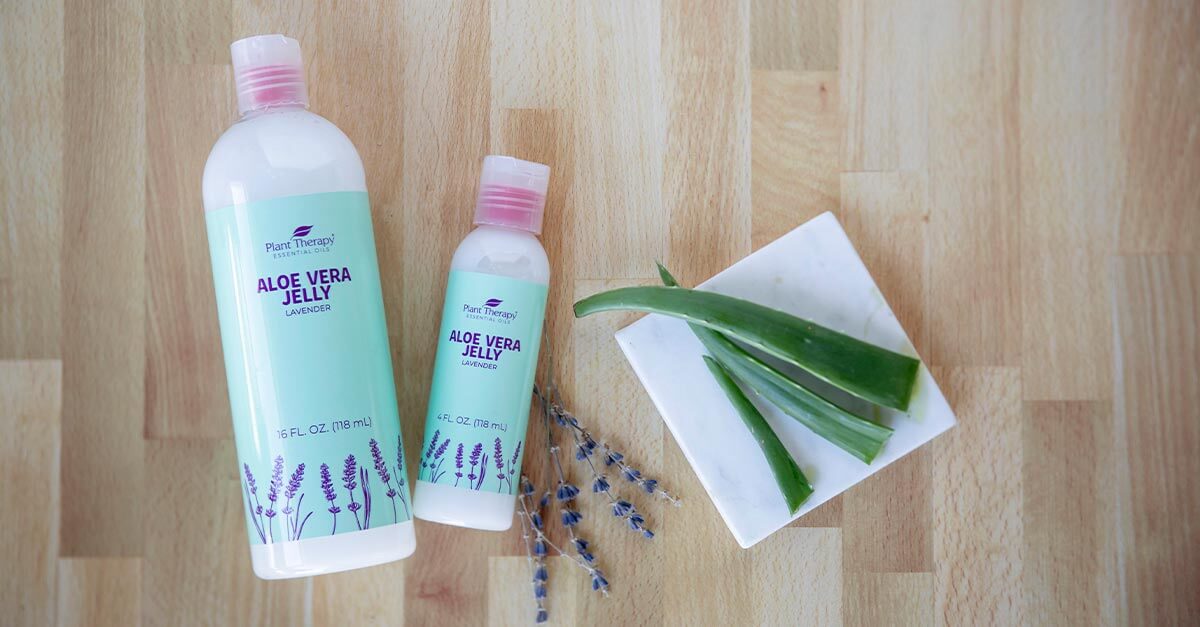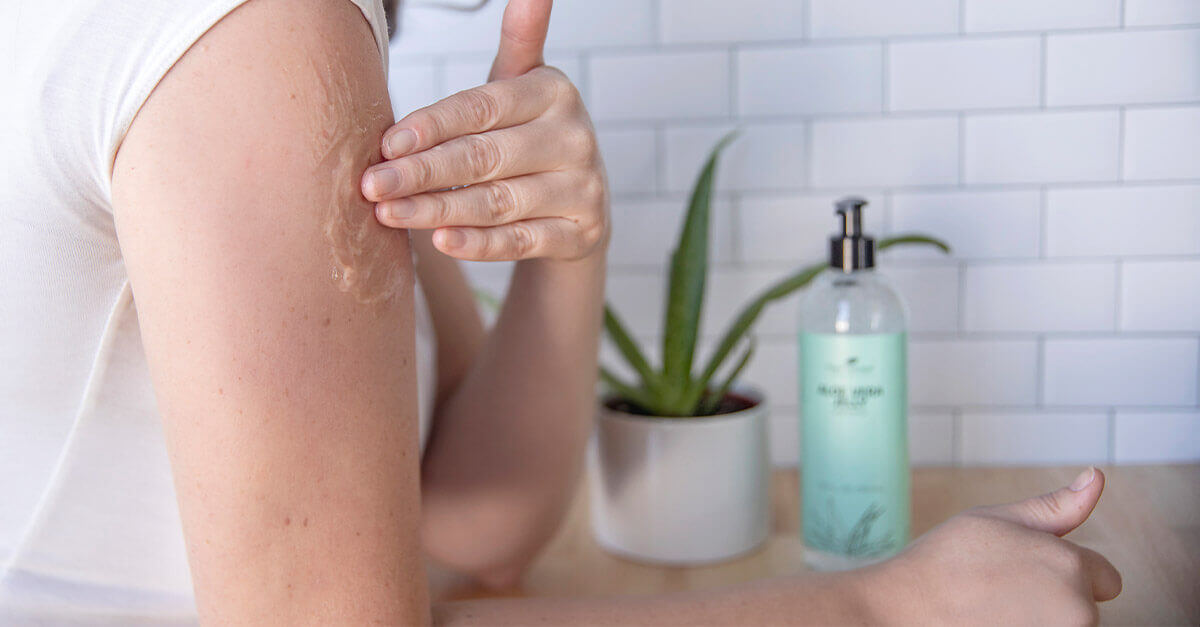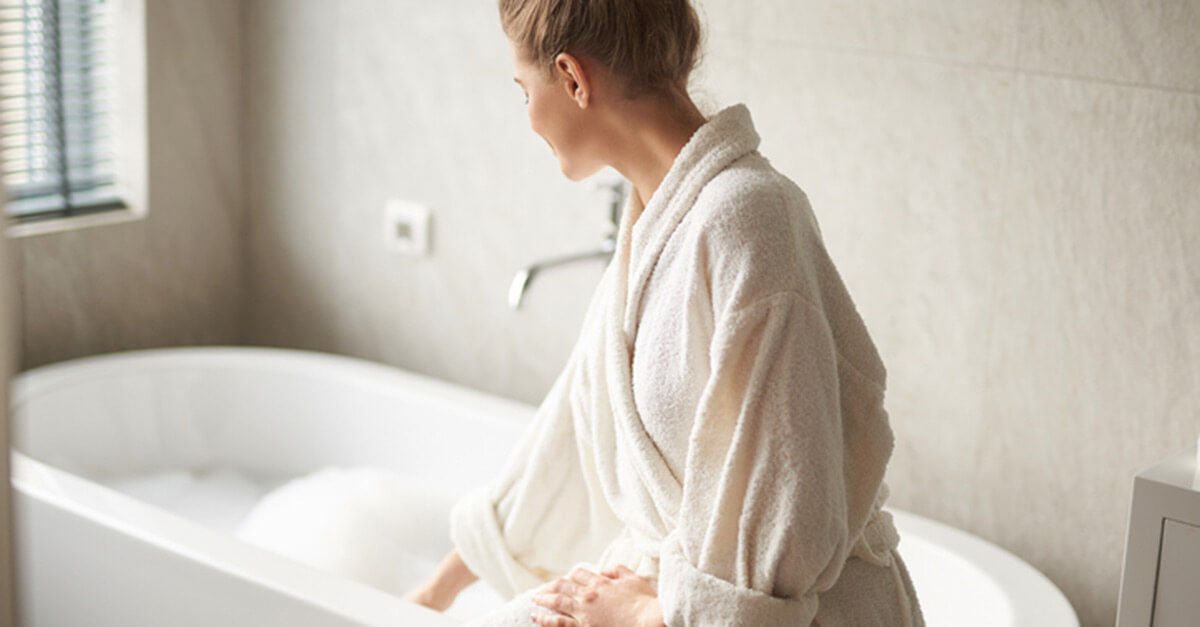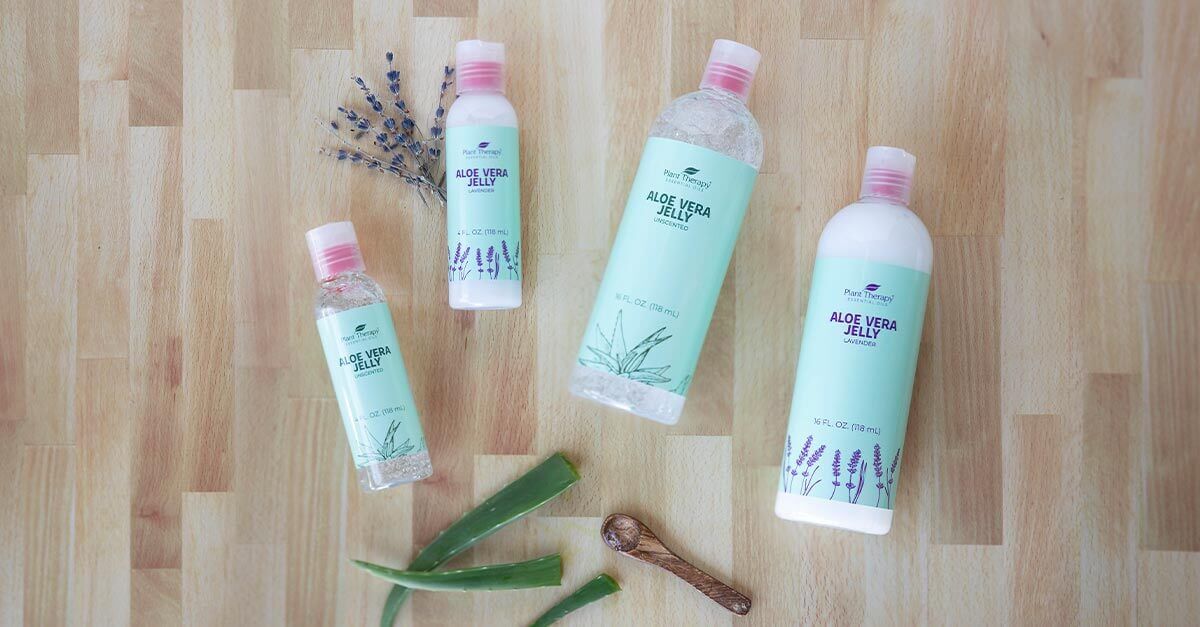If you haven’t tried Aloe Jellies yet, you’re missing out! Not only are they another amazing way to enjoy your essential oils, but they have incredible benefits of their own. They are soothing to the skin, moisturizing, cooling, and safe to use on sensitive skin. Let’s take a look at some of the amazing uses for Aloe Jelly.
First things first: If you’re lucky enough to have an Aloe plant in your home, you might be tempted to use it as a carrier for your essential oils. But because it is water-based, fresh Aloe Vera will not properly emulsify your oils, which could result in neat application of your oils.
Aloe Jelly, on the other hand, makes a perfect base for your favorite oils as it contains emulsifying and thickening agents. Plus, there are so, so many ways Aloe Jelly can be used!
Naturally Soothe a Sunburn
Aloe has long been a remedy for sun-burnt skin… and for good reason! Applying Aloe Jelly to your tender and burnt skin will be incredibly soothing, cooling, and moisturizing. It can give you much-needed relief when you need it the most. Plus, you can combine it with the skin-loving benefits of essential oils.

Lavender Aloe Jelly
Lavender, one of the most versatile oils out there, is incredibly soothing for the skin. You can use our pre-diluted Lavender Aloe Jelly or use this amazing DIY Sun Soother recipe.
We’ve all been burnt by the sun. If you forgot to reapply sunscreen or maybe just missed a spot, keep the Lavender Aloe Jelly nearby. Not only does the Aloe help soothe your red and tender skin, but Lavender essential oil is known for its ability to revitalize and soothe skin, including sunburns and minor cooking burns.
Soothing, cooling and incredibly hydrating, Aloe Jellies are a hidden gem. Try applying Lavender Aloe Jelly to your skin right after a shower, especially right after shaving, to help soothe and hydrate irritated legs. If you’re going on vacation, make sure to pack a seriously skin-soothing Lavender Aloe Jelly to use if your tan turns into a sunburn without warning.

Bug Bites, Poison Ivy…Reach for Aloe Jelly!
Calling all outdoorsy people! If you’ve spent any time hiking, camping and enjoying the great outdoors, you know just how much bug bites and itchy skin can absolutely ruin the experience. Instead of letting the itch get the better of you, use Aloe Jelly and some of our favorite essential oils for some relief. Check out this bug bite remedy featuring Blue Cypress or this balm to help with poison ivy.
Fire Fighter Blend
This DIY is perfect for fighting off the sting or itch that comes with pesky bug bites, and supporting quick healing. Plus, it’s safe to use on your kiddos over two years old!
What you’ll need:
- 1 Tbsp Aloe Vera Jelly
- 10 drops Blue Cypress
- 3 drops Chamomile German
- 3 drops Lavender
* If you have Chamomile German CO2, even better. Just reduce to 1 drop vs 3 of the essential oil.
What you’ll do:
Mix in a PET container. Apply as needed up to 4 times a day. This is a 3.5% dilution and is meant for short term use on local areas.
Cautions: Blue Cypress should not be used during pregnancy or with breastfeeding mothers. German Chamomile may have certain drug interactions. If choosing German Chamomile CO2, we recommend a 0.1% – 0.2% dilution for topical use.

Help Ease Sore Muscles
There can be a number of reasons for sore muscles: Exercise, yard work, or maybe you just slept wrong. Whatever the reason, Aloe Jelly is the perfect way to use essential oils to provide relief. Our Muscle Aloe Jelly has the perfect combination of essential oils to create a wonderful icy-hot effect. Plus it’s pre-diluted and ready to go. But if you love the DIY route, check out our Sore Muscle Master Blend that you can add to Aloe Jelly.
Muscle Aloe Jelly
Muscles hard at work deserve some pampering! This icy/hot combination soothes and relaxes muscles, helping them feel great and recover quicker. Any gym enthusiast will definitely appreciate some Muscle Aloe Jelly, especially after a hard workout. It dries quickly and goes to work immediately to help reduce the achy soreness that can come from a hard workout.
But the benefits of using Aloe Jelly on your body don’t stop there!

DIY Body Wash
Body wash is a natural fit for Aloe Jelly! Try this DIY to get clean and moisturize at the same time:
What you’ll need:
- 1/4 cup Shea or Mango Butter
- 1/8 cup Aloe Jelly
- 1/8 cup Jojoba
- 1 cup Castile Soap
- 1 tsp Xanthan Gum
What you’ll do:
Melt Shea or Mango Butter over a double boiler, then add Aloe Jelly and Jojoba. Remove from heat stir in Xanthan Gum & Castile Soap. Allow to cool slightly and add essential oils. Pour into a jar or container using a funnel.

Aloe Jelly and Honey Face Mask for Oily Skin
Use this DIY face mask to help keep your skin glowing and clear.
What you’ll need:
- 2 drops Lavender
- 1 drop Lemon
- 1 drop Cypress
- 2 Tbsp Aloe Vera Jelly
- 1 Tbsp Honey
What you’ll do:
Mix Aloe Vera Jelly and essential oils, then mix with honey. Apply to the face, avoiding the eye area. Let sit for 15-30 minutes. Wash off with lukewarm water and pat dry. Re-apply 2 times a week.

Aloe Jelly Slimming Gel
When you’re starting a new workout plan, whip up this DIY slimming gel to help firm and tighten the skin in your problem areas.
What you’ll need:
- 32 drops Grapefruit Pink
- 16 drops Basil Linalool
- 16 drops Juniper Berry
- 8 drops Rosemary 1,8-Cineole
- 4 ounces Aloe Vera Jelly
- 4-ounce bottle
What you’ll do:
Measure all ingredients. In a bowl, mix together well. Transfer to bottle.
To use:
Apply to areas of concern once a day for up to 4 days. To help maximize results you can wear a wrap for up to 45 minutes a day. Be sure to rinse well after use. The essential oils used in this all-natural gel are known to increase circulation, diminish the appearance of unwanted skin ripples, and firm and tighten your skin.

Funky Feet Aloe Jelly
Keep your feet healthy (and avoid smelling bad!) with this DIY using Aloe Jelly:
What you’ll need:
- 6 drops Citronella
- 5 drops Tea Tree
- 5 drops Cedarwood Virginian
- 2 drops Lemon
- 1 ounce Aloe Vera Jelly
What you’ll do:
Combine all ingredients and mix well. Apply to funky feet or toenails that result from being barefoot in shared showers or swimming pool areas.
*This DIY includes Lemon Essential Oil, which is a phototoxic oil. However, the amount of Lemon used here is much less than the 2% dilution recommended to avoid phototoxic reactions, so this DIY is perfectly safe for feet that love to soak up the sun!

DIY Hair Detangler
Try this all-natural DIY hair detangler to gently bring your hair back to a manageable state. Enriched with essential oils to nourish and moisturize your hair and scalp, this detangler will help protect your hair and prevent breakage after a day at the beach!
What you’ll need:
- 10 tsp Rose Organic Hydrosol
- 1 tsp Aloe Vera Jelly
- 1/2 tsp Vegetable Glycerin
- 1/2 tsp Apricot Kernel Carrier Oil
- 3 drops Lavender
- 3 drops Cedarwood Himalayan
What you’ll do:
First, mix the essential oils with the Aloe Vera Jelly; this will help dilute and disperse the essential oils throughout the hydrosol. Then add in the additional ingredients. Apricot Oil will sit on top of the water.
We highly recommend the addition of ½ tsp of Polysorbate 80 to encourage the carrier oil to disperse. However, if you choose not to add an emulsifier, please shake well before each use. To use, spray the detangler into your hair and gently comb through your hair.
*To extend the shelf life of this product refrigeration is necessary.

Natural Shampoo
There are few options for those who’ve ditched shampoo. Some wash with just water and call it good. Others use baking soda as a way to wash their hair, but many find this option harsh and drying. Instead, you can make your own DIY shampoo that’s more nourishing for your hair, helps with an oily scalp and adds some amazing essential oils. We have a great recipe you can try and see which one works best for your hair!
What you’ll need:
- 1 cup water
- 1 Tbsp baking soda
- 10 total drops of Lavender, Rosemary 1,8-Cineole, Cedarwood Himalayan, Clary Sage, Chamomile Roman, or Eucalyptus
- 1 Tbsp honey
- 1 Tbsp Aloe Vera Jelly
What you’ll do:
Dissolve baking soda into water. Add other ingredients, shaking well to combine. Use in place of your regular shampoo and condition as needed.
Hopefully, we’ve convinced you to give Aloe Jellies a try! For more great ways to use Aloe Jellies, be sure to check out our Facebook group, Safe Essential Oil Recipes (SEOR)!
by Plant Therapy



